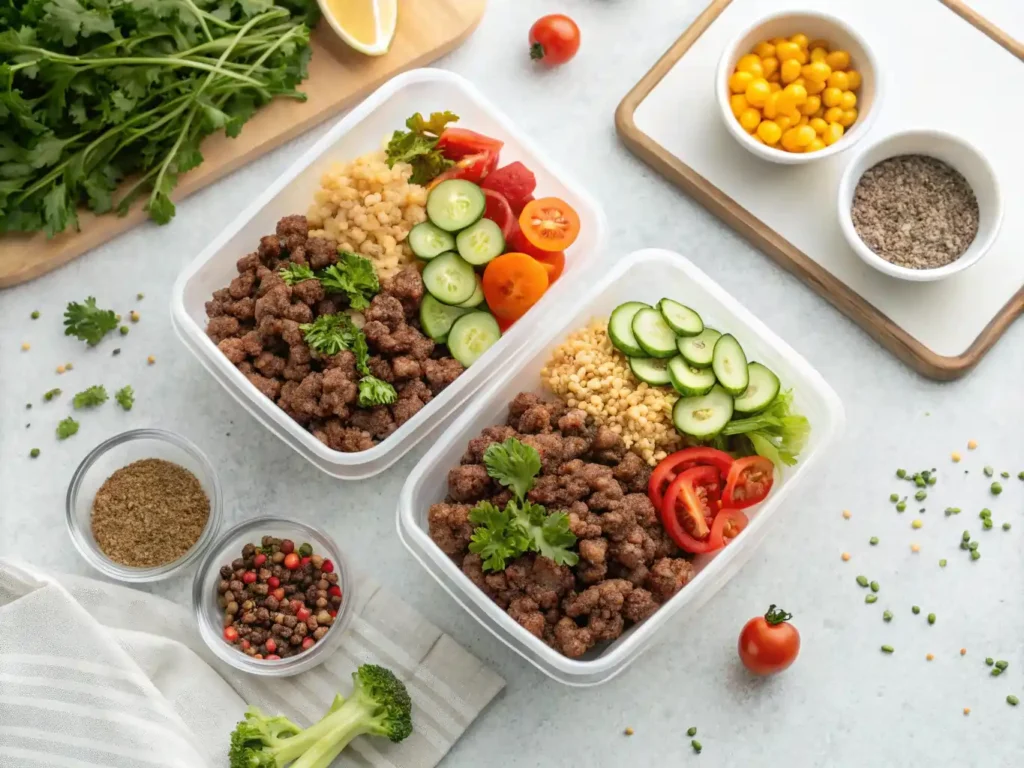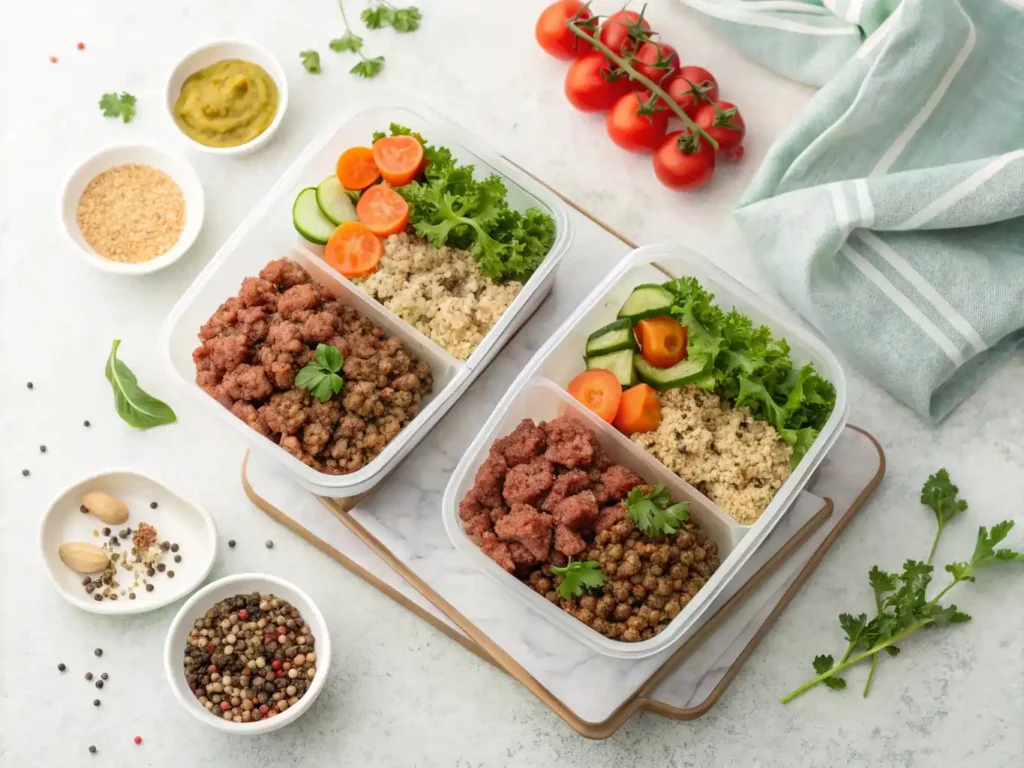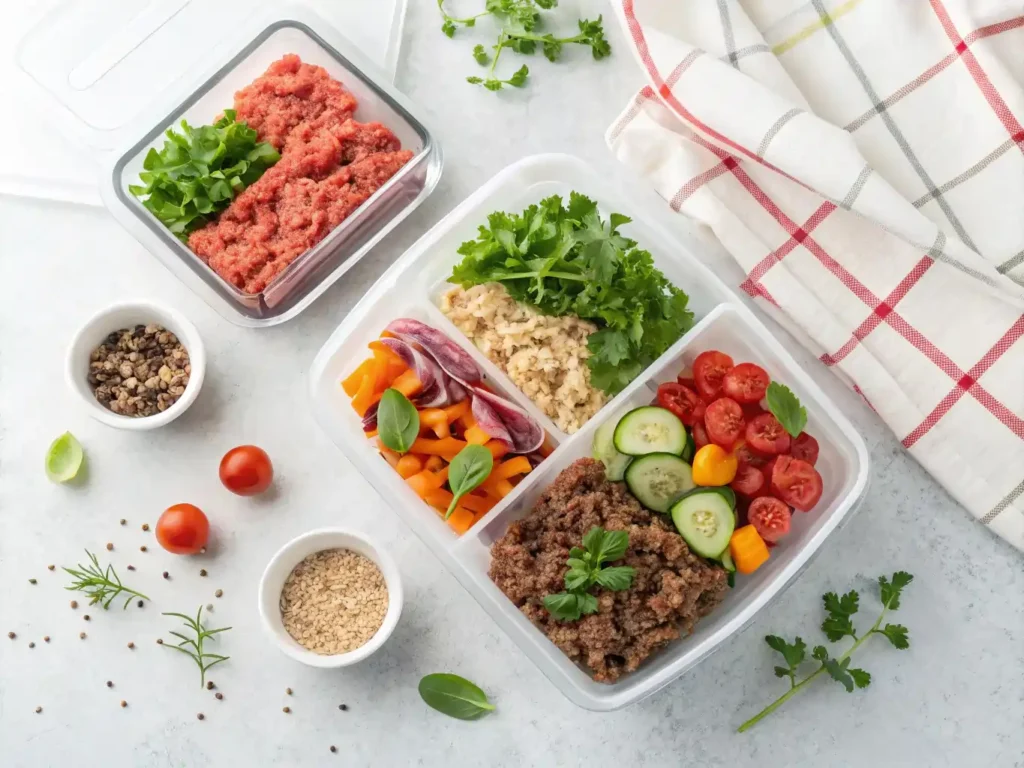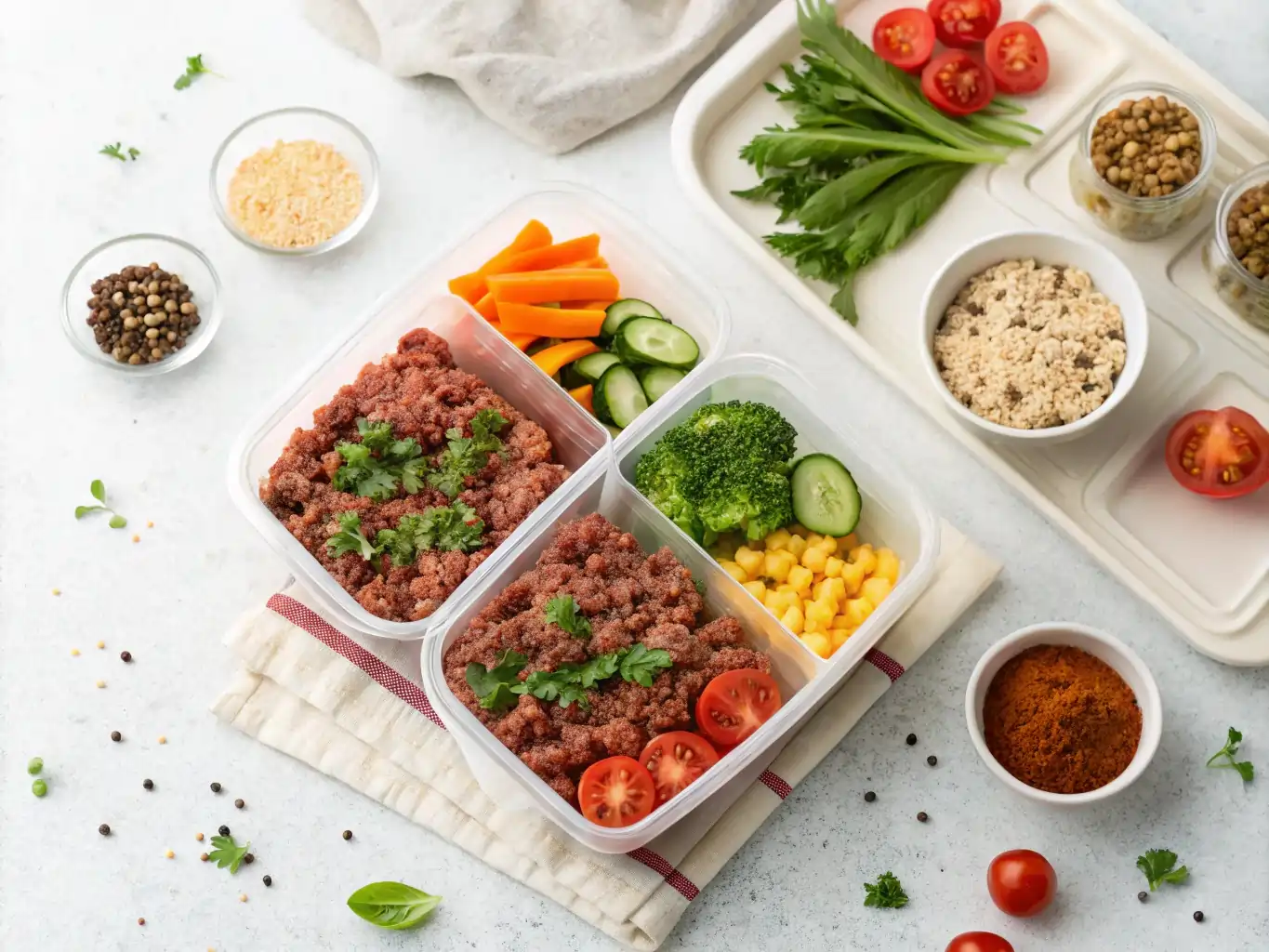Healthy Ground Beef Recipes: In this fast-paced world, it’s easy to feel overwhelmed by the idea of cooking daily meals that are both nutritious and budget-friendly. Fortunately, lean ground beef serves as a versatile, protein-packed weapon in your meal prep arsenal. Whether you’re feeding an entire family or just looking to keep cost-effective, healthy dishes on hand throughout the week, ground beef offers a convenient solution.
By blending ground beef with a variety of fresh vegetables, whole grains, and flavorful seasonings, you can quickly create balanced meals that check off all the boxes: taste, nutrition, and simplicity. This blog post guides you through a series of tips, tricks, and ready-to-go recipes designed to streamline your meal prep routine. From mastering the art of selecting healthy beef to discovering new ways to expand on classic dishes, these ideas will help make your kitchen time more efficient and enjoyable.
Lastly, if you’re looking for creative and nutrient-dense options that suit your specific dietary needs—such as low-carb, gluten-free, or dairy-free—don’t worry. We’ll cover that, too. By the end of this post, you’ll have a firm grasp on the basics of healthy ground beef meal prep, along with recipe ideas that prove you don’t have to sacrifice great flavor for the sake of convenience or health. Alright, it’s time to get hands-on and start whipping up something delicious!
Table of Contents
The Benefits of Lean Ground Beef for Meal Prep
When planning your weekly meal prep routine, lean ground beef can serve as a cornerstone for healthy, cost-effective, and family-friendly meals. Lean typically refers to 90% lean/10% fat or higher, so look for these labels at the grocery store to ensure you’re selecting the healthiest option possible. Below are the key reasons why lean ground beef is an excellent choice for meal prep:

- High-Protein Family Meals
Lean ground beef is an outstanding source of protein, aiding in muscle maintenance and overall health. Protein is also filling, so it helps stave off between-meal hunger pangs. When combined with vegetables and whole grains, you get a balanced plate that delivers the nutrients you need for sustained energy throughout the day. Because ground beef appeals to a wide range of palates, it’s a perfect solution for households with children or picky eaters. - Budget-Friendly Meat Choice
Meat can become a pricey grocery item, but ground beef often comes with a lower price tag compared to whole cuts like steaks or roasts. Lean varieties might cost slightly more than fattier types, yet they still tend to be economical when you factor in the reduced shrinkage and healthier fat profile. Stretching ground beef by incorporating vegetables and grains makes it even more cost-effective, allowing you to create multiple meal servings for the week without breaking the bank. - Versatile Cooking Options
Lean ground beef adapts well to numerous cooking styles—skillet, crockpot, baking, or grilling—so you never have to worry about repetitive dishes. Whether you’re craving classic comfort foods like meatballs or experimenting with global flavors in tacos, stir-fries, or curries, ground beef provides a convenient canvas for your favorite seasonings and spices. This flexibility is particularly helpful when you need to liven up your weekly meal rotation to prevent “food fatigue.” - Balanced Meal Opportunities
Pairing lean ground beef with nutrient-dense ingredients, such as fresh vegetables (bell peppers, onions, spinach) and whole grains (brown rice, quinoa), promotes a balanced plate. The final product delivers an ideal mix of proteins, vitamins, and minerals to support a healthy lifestyle. In addition, you can control sodium and fat content more effectively by creating your own spice mixes and sauces, as opposed to relying on heavily processed seasonings. This not only enhances the flavor but also allows you to tailor each dish to meet specific dietary preferences—whether that’s low-carb, gluten-free, or high-fiber.
Choosing the Right Ingredients and Seasonings
One key to successful meal prep is balancing nutrition, flavor, and convenience. By carefully selecting ingredients and seasonings, you can ensure every dish tastes delicious while still aligning with your health goals. Below are some considerations to guide your choices:

- Selecting Lean Ground Beef
Aim for 90% lean (or higher) ground beef to reduce overall fat content without sacrificing taste. Labels like “lean” or “extra lean” typically indicate a significantly lower fat percentage, delivering protein-focused nutrition and minimizing grease during cooking. Look at the nutritional labels to confirm you’re choosing the healthiest option available, and be mindful that leaner ground beef not only looks less oily after cooking but also helps control daily calorie intake. - Incorporating Fresh Vegetables
Incorporating vegetables like onions, bell peppers, mushrooms, spinach, or even grated zucchini enriches your ground beef dishes with essential vitamins and minerals. These ingredients also add moisture and depth of flavor. The vibrant colors and textures are both visually appealing and beneficial to your health, making it easier to stick to a nutritious eating plan. For extra convenience in meal prep, chop your vegetables in bulk and store them in airtight containers, ready to toss into any ground beef recipe throughout the week. - Optimal Seasoning Blends
Creating your own seasoning mixes allows you to control sodium levels and tailor the taste profile to your preferences. A basic seasoning blend might include salt, pepper, garlic powder, onion powder, and paprika. From there, you can customize with dried herbs (basil, oregano, thyme) or bolder elements like chili flakes or cayenne pepper for extra heat. Experimenting with different spice combinations ensures variety in your ground beef dishes while preventing flavor fatigue over the course of multiple meal-prep servings. - Avoiding Unnecessary Additives
While pre-packaged seasoning packets may seem convenient, they often contain high amounts of salt, sugar, and artificial ingredients. Instead of relying on processed mixes or sauces, consider fresh ingredients like garlic, ginger, or a splash of low-sodium soy sauce to add natural flavor enhancements. By keeping an eye on nutrition labels and opting for minimally processed options, you’ll create meals that are not only healthier but also free from excess additives that could diminish the quality of your dishes over time.
Five Quick and Healthy Ground Beef Recipes
Whether you have limited time in the evening or want to streamline your weekly menu, these ground beef recipes are both nutritious and straightforward to prepare. By adding vegetables, whole grains, and flavorful seasonings, you’ll enjoy the benefits of lean protein without unnecessary additives.

- Skillet Beef and Veggie Stir-Fry
This one-pan dish is perfect for busy weeknights. Simply brown lean ground beef with garlic and onions, then add chopped bell peppers, mushrooms, and zucchini. Stir in a splash of low-sodium soy sauce or a homemade stir-fry sauce (made with cornstarch, broth, and ginger) to create a lightly thickened glaze over the meat and veggies. Serve it all over brown rice or quinoa for extra fiber and a satisfying final touch. The skillet method keeps cleanup minimal while helping you infuse vibrant flavor into lean beef and produce. - Ground Beef Lettuce Wraps
If you’re aiming for a lower-carb meal option, these lettuce wraps deliver the perfect balance of taste and convenience. Cook up the ground beef with diced onions, garlic, and a small amount of reduced-sodium soy sauce or hoisin sauce. Add finely chopped water chestnuts or mushrooms for a subtle crunch and an extra layer of texture. Spoon the mixture into crisp lettuce leaves (e.g., iceberg or butter lettuce) and top with green onions or sesame seeds. This dish is not only quick to assemble but also refreshing and portion-controlled—great for midday meals or light dinners. - Crockpot Chili
For a hearty, hands-off meal, lean ground beef chili fits the bill. Brown the beef with onions and garlic in a skillet, then transfer it to your slow cooker. Combine the beef with low-sodium canned tomatoes, beans (kidney, black, or pinto), chopped bell peppers, and your favorite chili seasoning (cumin, paprika, chili powder, and a hint of cayenne for heat). Let the chili simmer on low for 6–8 hours or high for 3–4 hours, allowing flavors to meld beautifully. Serve it with Greek yogurt or low-fat sour cream as a healthy garnish. This dish freezes well, so you’ll always have an extra nutrient-packed meal on standby. - Baked Meatballs with Whole Wheat Pasta
Meatballs are a classic favorite that can easily be adapted into a healthier version. Combine lean ground beef with breadcrumbs (consider whole wheat breadcrumbs for added fiber), an egg, minced onion, garlic, and Italian seasonings. Roll the mixture into small balls and bake them on a sheet pan at around 400°F (200°C) for 15–20 minutes, or until cooked through. Pair these meatballs with whole wheat pasta and your sauce of choice—marinara or a homemade tomato sauce with fresh herbs—creating a balanced, family-friendly dinner. - Taco Bowl
Craving Tex-Mex? Achieve those bold flavors in a balanced format by browning lean ground beef with onions, garlic, chili powder, and paprika. Serve it over a base of brown rice or cauliflower rice to up the fiber or reduce carbs. Add black beans or pinto beans, then load up on fresh toppings like chopped tomatoes, shredded lettuce, corn, avocado slices, and a sprinkle of low-fat cheese. Finish with a zesty lime crema made from Greek yogurt and freshly squeezed lime juice. This dish is infinitely customizable, fitting various dietary preferences and perfect for weekly meal prep.
Tips for Efficient Meal Prepping
Meal prepping with ground beef can be a lifesaver when you’re juggling a busy lifestyle. By getting organized and planning ahead, you’ll save both time and money throughout the week. Below are a few detailed strategies to help you streamline your process:
- Cook in Batches
By cooking multiple pounds of lean ground beef at once, you can easily divide and transform it into several meals. For example, you might brown a few pounds of ground beef in a single skillet, then portion it out for different recipes such as tacos, meat sauce, or chili. This method reduces your active cooking time and ensures you have a head start on various dishes throughout the week. - Using Meal Prep Containers
After fully cooking and cooling your ground beef meals, transfer them into airtight containers. Clear containers help you see what’s inside without having to open them. Consider portion-sized containers if you want ready-to-go lunches or dinners—this way, everything is pre-measured, and you don’t have to worry about unbalanced portion sizes. Investing in high-quality containers also minimizes leaks and helps maintain freshness. - Labeling and Dating
Proper labeling is essential for keeping track of what you’ve already cooked. Use simple sticky notes, masking tape, or a permanent marker to note the recipe name and the date it was prepared. This step ensures you know exactly what’s in each container and helps you prioritize usage before items pass their shelf life. Knowing how long your meals keep in the fridge—usually up to four days for most cooked dishes—prevents waste and maintains food safety. - Reheating and Maintaining Quality
Because ground beef is relatively easy to reheat, you have multiple warming options at your disposal. For faster results, use a microwave at short intervals, stirring midway to distribute heat evenly and avoid drying out the edges. Alternatively, reheat your meals on the stovetop in a skillet with a splash of broth or water to revive moisture. If your dish contains large chunks of vegetables, monitor them carefully so they don’t become overly soft. By reheating gently, you’ll maintain both the taste and texture of your prepared meals.
Balancing Flavor and Nutrition
Crafting delicious meals with ground beef doesn’t have to mean sacrificing your health goals. By combining the right ingredients, cooking methods, and mindful seasoning choices, you can boost both taste and nutritional benefits. Below are key approaches for striking the perfect balance:
- Nutrition Facts and Monitoring Macros
Keeping track of protein, carbs, and fats is beneficial for anyone seeking to meet specific health goals, whether that involves building muscle or losing weight. Lean ground beef naturally lends itself to higher protein and lower fat, especially if you choose 90% or 93% lean varieties. Pairing it with nutrient-dense veggies and complex carbs (brown rice, quinoa, whole wheat pasta) ensures your meals offer energy-sustaining carbohydrates and muscle-building protein in one plate. - Adding Whole Grains for Fiber
Whole grains such as brown rice, quinoa, and whole wheat pasta all provide extra fiber, which aids in digestion and helps you stay satiated. Including these grains alongside ground beef expands your meal’s flavor profile and texture. Opting for fiber-rich complex carbohydrates instead of refined grains also helps regulate blood sugar levels and supports overall digestive health. - Relying on Fresh Herbs and Aromatics for Flavor
Instead of leaning solely on salt or high-sodium sauces, experiment with fresh herbs (like rosemary, basil, thyme) and aromatics (garlic, onions, ginger) to layer complex flavors into your dishes. These ingredients add brightness and depth without piling on unnecessary calories or salt. For example, stir-fries can be transformed with minced ginger and garlic, while basil or oregano can breathe new life into tomato-based sauces. - Adapting to Dietary Needs
Whether you’re low-carb, gluten-free, or dairy-free, ground beef is flexible enough to fit seamlessly into a range of diets. If you need to reduce carbs, skip the grains and focus on hearty vegetables such as zucchini, bell peppers, and spinach. If gluten isn’t an option, try cauliflower rice or gluten-free pastas made from quinoa or lentils. Dairy-free meal variants can feature plant-based cheese alternatives or yogurt substitutes for toppings and garnishes.
Conclusion
Like any lifestyle change, adopting a healthy eating routine takes time and exploration. You’ll likely discover new seasoning combinations or cooking methods that best fit your palate along the way. Ground beef, particularly lean varieties, remains a reliable and budget-friendly ingredient for Anchoring your meal prep. When combined with fresh vegetables, herbs, and hearty grains, a simple protein source can transform into an array of vibrant meal options.
Whether you’re creating quick skillet stir-fries, hearty crockpot chili, light lettuce wraps, or a taco bowl with all the fixings, each recipe can be customized to suit your unique health goals, dietary restrictions, and flavor preferences. This flexibility ensures that no matter how busy life gets, you’ll always have nourishing, delicious meals ready to go—saving you time and reducing the temptation of less nutritious choices.
From selecting the right beef at the grocery store to batching your cooking, the strategies you’ve learned throughout this post aim to make healthy eating more approachable. By following these tips—balancing flavored-packed seasonings with nutritional priorities, planning meals in advance, and practicing smart storage—you’ll gain confidence in the kitchen and a real sense of enjoyment in preparing wholesome, satisfying dishes. Above all, remember that healthy eating should be sustainable and enjoyable: strive for small, consistent improvements in your process, and allow creativity to spark your next great ground beef meal idea.

